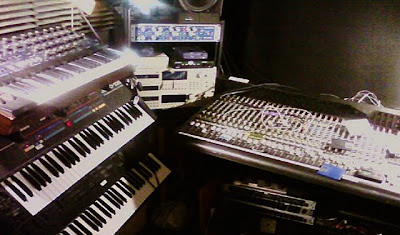
the main joy of having your own recording space is what you can have on hand to use at a moment's notice. the new album has a broader palette of sounds than before because more of it was worked on in the rehearsal studio, which also has a recording setup.
previous dream into dust albums were mainly recorded in my home studio, "elsewhere" (shown above). it was originally my intent to just do a few overdubs with other musicians in the rehearsal space and return home to finish them off. but once the album got into the group environment, it increased in scope. for one thing, we had the ability to record live as a band to separate tracks, a technique most obviously put to use on the new album's 5 instrumental pieces.
the studio began as rehearsal space for bryin dall's old band, loretta's doll, and morphed to include a recording component and easy-acces playground of bizarre instruments. over the years, it's been the center of activity for 4th sign of the apocalypse, a murder of angels, and our soundtrack work for the ballad of genesis and lady jaye, among many others.
bryin's collection of analog synthesizers easily made their way into the sound of the new album. i've always loved them, but used to prefer sample manipulation to synthesis as a basic building block. not anymore. i got to use the roland SH-101 and jupiter-8, sequential circuits pro-one, and ended up buying my own juno-106(though technically a digital synth, it has analog filters that fatten the sound). bryin played his ionic performer, cat and kitten.
the other great thing about using a studio is being able to be loud whenever you want. this comes into play when using electric guitars and amps, which happened a lot more on this album than before. there were at least two different tube amps used (vox and selmer), several different distortion and chorus pedals, and i've lost count of the number of different guitars and basses that ended up on the songs. whatever sound was in my head, or if i was at a loss, i could look around and pick an instrument that might hold the answer.
of course, some of this cornucopia of choices turned out to be discarded, but being able to pursue an idea to its conclusion was great. it was also time-consuming, but in the end i think it was worth it for the range of sounds we were able to capture on the album.
to hear pieces of about 5 of the 55 miniutes that make up the new album, see the trailer video, and pre-order so beautiful and so dangerous until march 29th using paypal here.
